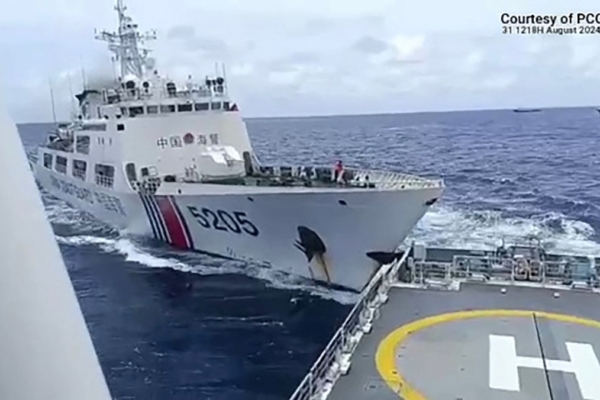On Saturday, August 31, the Philippines and China accused each other of deliberately ramming coast guard vessels in the disputed waters of the South China Sea, the latest incident in the escalating tensions between the two countries in the South China Sea.
The collision near Sabina Shoal was the fifth maritime clash within a month between the two nations.
The Philippines presidential office issued a statement stating that another incident of Chinese infringement occurred on Saturday. Jay Tarriela, spokesman for the Philippine Coast Guard, played a video of the clash during a press conference, alleging that the Chinese coast guard vessel, identified as 5205, intentionally rammed the Philippine vessel, BRP Teresa Magbanua. The Philippine vessel sustained damage from multiple intentional collisions by the Chinese coast guard ship. Fortunately, no personnel were injured.
BRP Teresa Magbanua, 97 meters (320 feet) long, is one of the largest cutters in the Philippine Coast Guard fleet.
Tarriela mentioned that initially, the Philippine vessel was surrounded by numerous Chinese navy and militia ships in different areas near where the Philippine Coast Guard ships were anchored.
He added that around 12:07 PM on Saturday, while the Philippine Coast Guard ship was still in motion, the Chinese coast guard vessel carried out a “dangerous maneuver,” resulting in a direct collision on the port bow of the BRP Teresa Magbanua. The Chinese ship then made a turn and hit the starboard stern of the Philippine vessel. He emphasized that it was apparent the Chinese vessel disregarded international maritime collision rules.
Liu Dejun, spokesperson for the Chinese Coast Guard Bureau, countered by accusing the Philippines of being responsible for the collision. He claimed that Philippine ship 9701 intentionally rammed the Chinese coast guard vessel 5205 in an unprofessional and dangerous manner, leading to the collision, placing the blame entirely on the Philippines.
Liu warned the Philippines to immediately withdraw their ships or face the consequences.
The Philippine Coast Guard spokesperson, Tarriela, stated that despite Chinese Coast Guard engaging in “harassment, intimidation, and escalating actions,” the Philippines would not retract their vessels.
The United States reiterated its support for the Philippines and condemned China’s encroachment. MaryKay Carlson, U.S. Ambassador to the Philippines, expressed condemnation on the social media platform X, criticizing Beijing for repeatedly “dangerously violating international law, including the intentional collision today.”
China claims sovereignty over nearly the entire South China Sea based on the “Nine-Dash Line,” which overlaps with the exclusive economic zones of the Philippines, Vietnam, Malaysia, Brunei, and Indonesia in some areas, leading to disputes. On July 12, 2016, the Hague International Tribunal ruled that China’s sovereignty claims in the South China Sea based on the Nine-Dash Line have no legal basis. However, China stated that they do not recognize the ruling.
In recent years, conflicts between China and the Philippines in the South China Sea have attracted international attention, with tensions continuing to rise.
On August 29, Samuel Paparo, Commander of the U.S. Indo-Pacific Command, stated that amid increasing hostile actions between China and the Philippines in the disputed waters, the U.S. military, after negotiating treaties with the Philippines, is willing to escort Philippine vessels in the South China Sea.
Such developments could potentially lead to direct confrontations between U.S. Navy ships and Chinese vessels.
(部分翻譯參考自路透社報導。)

